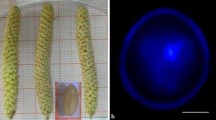Summary
Microspore culture was shown to be applicable to a broad range of accessions belonging to six horticulturally important crop types of Brassica oleracea: broccoli, white cabbage, cauliflower, savoy cabbage, Brussels sprouts and curly kale. Of 64 accessions tested 86% were responsive. Large genotypic differences were found in number of embryos produced per flower bud, and in frequency and mode of regeneration of plants from embryos.
B. oleracea was characterized by a strong asynchrony of microspore development within single buds. Microspore populations optimal for culture contained a large proportion (10–40%) of binucleate pollen. An initial high temperature treatment was essential for microspore embryogenesis. Growth conditions of the donor plants during inflorescence formation were less critical.
Similar content being viewed by others
References
Arnison, P.G., P., Donaldson, L.C.C., Ho & W.A., Keller, 1990. The influence of various physical parameters on anther culture of broccoli (B. oleracea var. italica). Plant Cell Tiss. Org. Cult. 20: 147–155.
Cao, M.Q., F., Charlot & C., Doré, 1990. Embryogenèse et régénération de plantes de chou à choucroute (Brassica oleracea L. ssp. capitata) par culture in vitro de microspores isolées. C. R. Acad. Sci. Paris Série III 310: 203–209.
Chuong, P.V. & W.D., Beversdorf, 1985. High frequency embryogenesis through isolated microspore culture in Brassica napus L. and B. carinata Braun. Plant Sci. 39: 219–226.
Chuong, P.V., C., Deslauriers, L.S., Kott & W.D., Beversdorf, 1988. Effect of donor genotypes and bud sampling on microspore culture of Brassica napus. Can. J. Bot. 66: 1653–1657.
Gamborg, O.L., R.A., Miller & K., Ojima, 1968. Nutrient requirements of suspension cultures of soybean cells. Exp. Cell Res. 50: 151–158.
Gland, A., R., Lichter & H.-G., Schweiger, 1988. Genetic and exogenous factors affecting embryogenesis in isolated microspore cultures of Brassica napus L. J. Plant Physiol. 132: 613–617.
Keller, W.A. & K.C., Armstrong, 1981. Production of anther-derived dihaploid plants in autotetraploid marrowstem kale (Brassica oleracea var. acephala). Can. J. Genet. Cytol. 23: 259–265.
Keller, W.A., P.G. Arnison & B.J. Cardy, 1987. Haploids from gametophytic cells — recent developments and future prospects. p. 223–241. In: C.E. Green et al. (Eds). Proc. 6th Int. Congr. Plant Tiss. Cell Cult. Alan R. Liss, Inc., New York.
Keller, W.A., T., Rajhathy & J., Lacapra, 1975. In vitro production of plants from pollen in Brassica campestris. Can. J. Genet. Cytol. 17: 655–666.
Kott, L.S., L., Polsoni & W.D., Beversdorf, 1988a. Cytological aspects of isolated microspore culture of Brassica napus. Can. J. Bot. 66: 1658–1664.
Kott, L.S., L., Polsoni, B., Ellis & W.D., Beversdorf, 1988b. Autotoxicity in isolated microspores of Brassica napus. Can. J. Bot. 66: 1665–1670.
Lelu, M.-A. & H., Bollon, 1985. Obtention d'haploïdes par culture d'anthères de Brassica oleracea var. capitata et var. gemmifera. C. R. Acad. Sci. Paris Série III 300: 71–76.
Lichter, R., 1981. Anther culture of Brassica napus in a liquid culture medium. Z. Pflanzenphysiol. 103: 229–237.
Lichter, R., 1982. Induction of haploid plants from isolated pollen of Brassica napus. Z. Pflanzenphysiol. 105: 427–434.
Lichter, R., 1989. Efficient yield of embryoids by culture of isolated microspores of different Brassicaceae species. Plant Breed. 103: 119–123.
Morrison, R.A. & D.A., Evans, 1988. Haploid plants from tissue culture: new plant varieties in a shortened time frame. BioTechnology 6: 684–692.
Ockendon, D.J., 1985. Anther culture in Brussels sprouts (Brassica oleracea var. gemmifera) II. Effect of genotype on embryo yields. Ann. Appl. Biol. 107: 101–104.
Pechan, P.M. & W.A., Keller, 1988. Identification of potentially embryogenic microspores in Brassica napus. Physiol. Plant 74: 377–384.
Polsoni, L., L.S., Kott & W.D., Beversdorf, 1988. Large-scale microspore culture technique for mutation-selection studies in Brassica napus. Can. J. Bot. 66: 1681–1685.
Sato, T., T., Nishio & M., Hirai, 1989. Plant regeneration from isolated microspore cultures of Chinese cabbage (Brassica campestris ssp. pekinensis). Plant Cell Rep. 8: 486–488.
Swanson, E.B., M.P., Coumans, S.C., Wu, T.L., Barsby & W.D., Beversdorf, 1987. Efficient isolation of microspores and the production of microspore-derived embryos from Brassica napus. Plant Cell Rep. 6: 94–97.
Takahata, Y. & W.A., Keller, 1991. High frequency embryogenesis and plant regeneration in isolated microspore culture of Brassica oleracea L. Plant Sci. 74: 235–242.
Thomas, E. & G., Wenzel, 1975. Embryogenesis from microspores of Brassica napus. Z. Pflanzenzüchtg. 74: 77–81.
Author information
Authors and Affiliations
Rights and permissions
About this article
Cite this article
Duijs, J.G., Voorrips, R.E., Visser, D.L. et al. Microspore culture is successful in most crop types of Brassica oleracea L.. Euphytica 60, 45–55 (1992). https://doi.org/10.1007/BF00022257
Received:
Accepted:
Issue Date:
DOI: https://doi.org/10.1007/BF00022257




